Featured Authors
 Armen Panossian
Armen Panossian
Head of Performing Credit and Portfolio Manager
 Danielle Poli, CAIA
Danielle Poli, CAIA
Managing Director, Multi-Asset Credit Product Specialist and Head of the Product Specialist Group
WHATEVER IT TAKES
Loose U.S. fiscal and monetary policy helped fuel abnormal economic trends, such as the massive spike in personal income, that boosted GDP growth in 2021. But these trends are normalizing just as rapidly rising inflation is forcing the Fed to accelerate its timeline for tightening monetary policy. The economy is therefore transitioning into a new phase, in which businesses, consumers and investors will have far less government support.
In January, we argued that the U.S. economy was facing a challenging transitional period, as the Federal Reserve was set to tighten monetary policy just as the fiscal-policy-induced sugar high was wearing off. The pace of this transition, like the U.S. inflation rate, accelerated in the early months of 2022. This is partly because the war in Ukraine disrupted already-fragile supply chains and boosted commodity prices, putting even more pressure on the Fed to bring down the elevated inflation rate, which hit 8.5% in the year through March.1 That’s the highest rate in over forty years (see Fig. 1).
This pressure was evident when Fed Chair Jay Powell gave the Semiannual Monetary Policy Report to the Congress on March 3. Senator Richard Shelby (R-AL) asked Chair Powell if he was “prepared to do what it takes without any reservation[s] to protect price stability” like former Fed Chair Paul Volcker, who famously helped cause a double-dip recession in the 1980s by raising the federal funds rate to more than 20%.2 Chair Powell answered in the affirmative and referred to his predecessor as “the greatest economic public servant of the era.” Powell’s response suggests that not only is he willing to take his foot off the gas – he’s also prepared to slam on the breaks.
While today’s uncertain macroeconomic and geopolitical environment is creating risk in securities markets – particularly for fixed-rate assets – we believe it’s also generating compelling opportunities for investors able to withstand a bumpy ride.
Figure 1: U.S. Inflation Has Climbed to a Four-Decade High
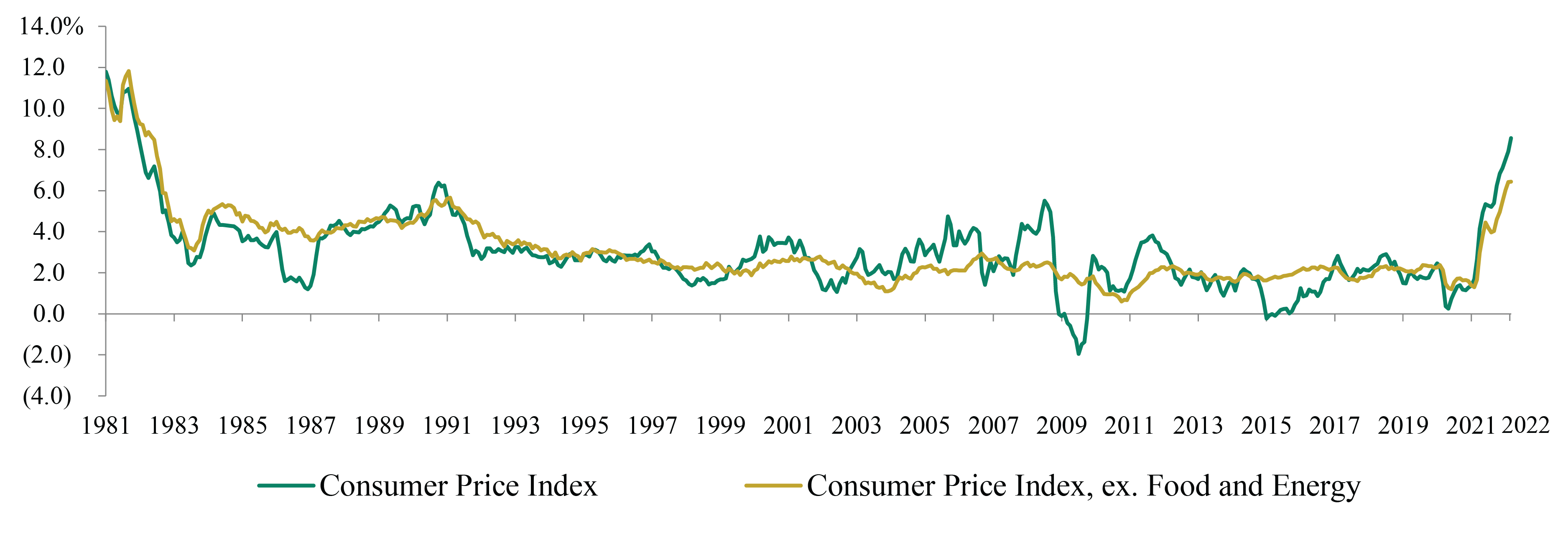
Source: U.S Bureau of Labor Statistics
IN THE REARVIEW MIRROR
During the first quarter, central banks in the U.S., Europe and the United Kingdom all adopted increasingly hawkish policy stances. When Russia invaded Ukraine on February 24, investors initially reacted as though they believed the war would slow the pace of interest rate hikes. But the central bankers quickly made it clear that they were more concerned about the conflict’s potential impact on price increases than on economic growth.
In March, the Fed not only boosted the federal funds rate target for the first time since 2018, but it also indicated that (a) six more hikes are likely in 2022; (b) interest rate increases of more than 25 basis points are possible at future meetings; and (c) it will soon begin quantitative tightening, i.e., reducing its $9 trillion balance sheet. Markets are currently expecting another 225 basis points in interest rate increases through year-end (see Fig. 2).3
Figure 2: Markets Are Pricing in a Large Increase in Interest Rates in 2022
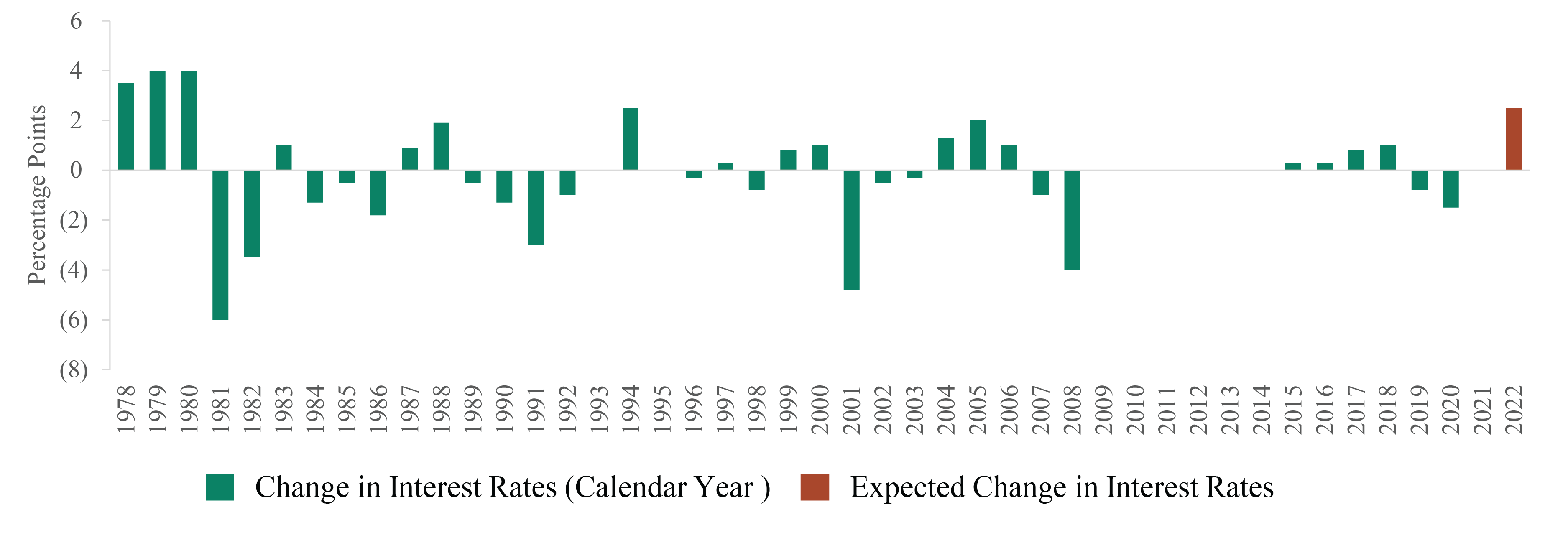
Source: Bloomberg
Note: Implied rate based on Overnight Index Swaps, as of April 6, 2022.
During the same month, the Bank of England raised its key interest rate for the third consecutive time and suggested that future hikes may be necessary to combat the UK’s soaring annual inflation rate, which reached 7.0% – a 30-year high – in March. Meanwhile, the European Central Bank – which has been the most dovish of the three major central banks in recent years – surprised markets on February 3 when President Christine Lagarde refused to rule out the possibility of increasing interest rates in 2022. This caused a dramatic spike in the expected change in short-term interest rates in Europe (see Fig. 3). Moving forward, the ECB and BoE may be in increasingly difficult positions, as the war in Ukraine could cause economic activity to weaken at the same time that it pushes commodity prices – and thus inflation – higher.
Figure 3: Interest Rate Expectations Have Spiked in Europe
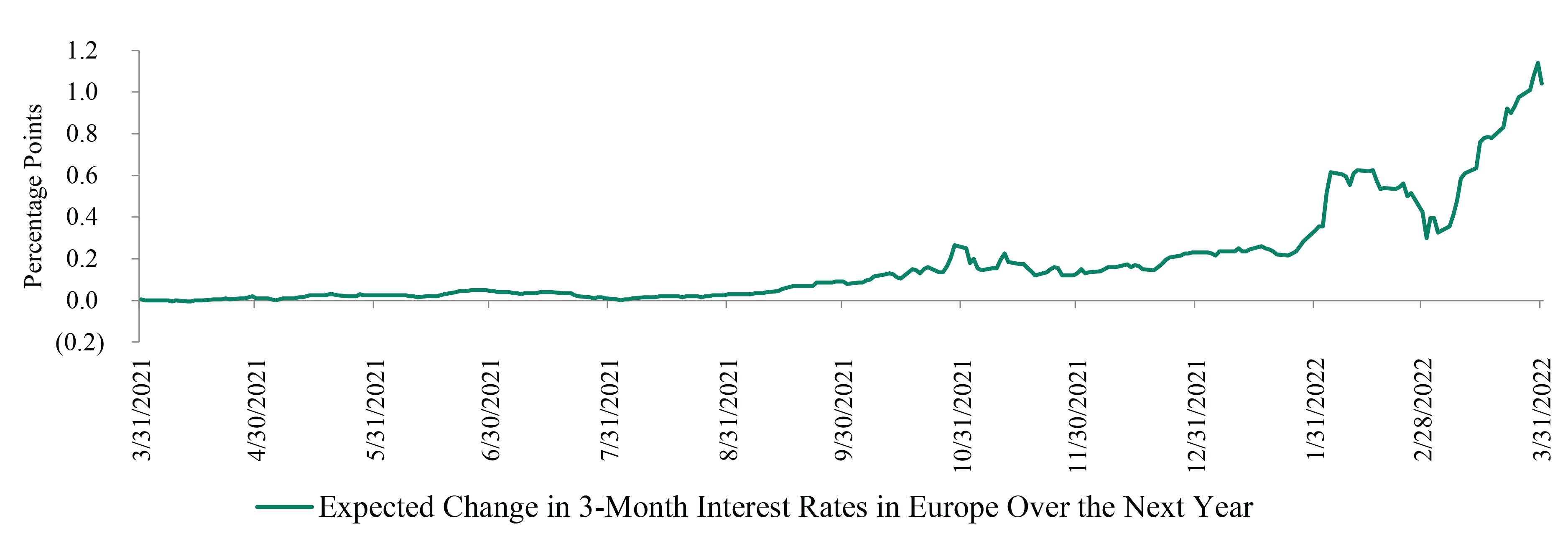
Source: Bloomberg4
Uncertainty surrounding the pace of monetary policy tightening and the economic implications of the war in Ukraine created volatility across credit and equity markets in the first quarter. While securities prices rallied in the final weeks of March, most asset classes recorded losses for the quarter. The total return on the 10-year Treasury note was minus 6.9%, putting this risk-free asset on track for its worst annual decline in over 40 years.5 Meanwhile, prices of U.S. large cap equities, investment grade bonds, and high yield bonds declined by 4.6%, 7.7%, and 4.3%, respectively.6
U.S. leveraged loan prices were far less volatile by comparison and ended the period roughly where they started (see Fig. 4). This outperformance was unsurprising, as (a) floating interest rates enable securities to hold their value despite interest rate changes; (b) investors often prefer floating-rate assets over fixed-rate alternatives when monetary policy is tightening; and (c) the dramatic increase in short-term interest rates in the U.S. during the quarter caused the expected income from leveraged loans to exceed that of high yield bonds.7
Figure 4: Loans Have Been Less Volatile Than High Yield and Investment Grade Bonds
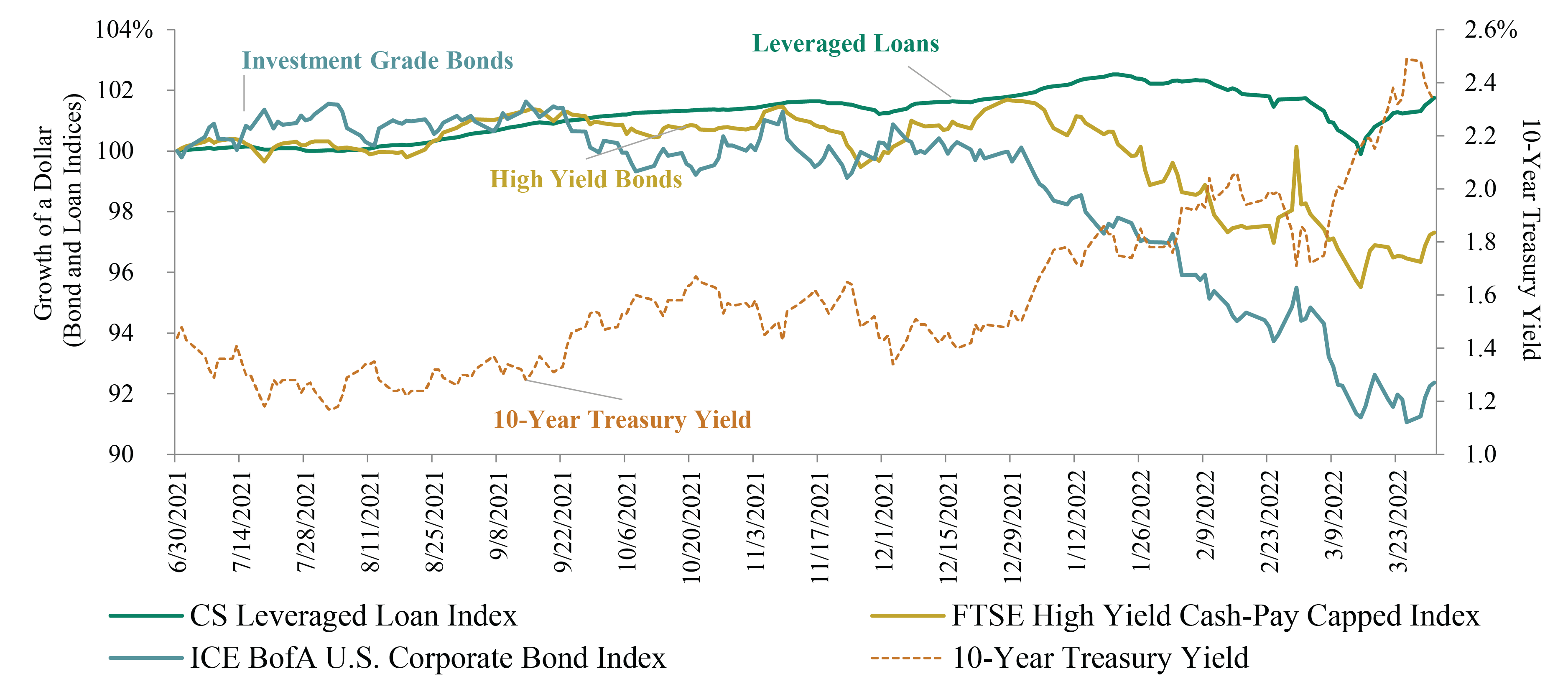
Source: Credit Suisse, Bank of America, FTSE, U.S. Treasury
WARNING: WINDING ROAD AHEAD
In January, we wrote the following in Performing Credit Quarterly 4Q2021:
Damage to businesses caused by the pandemic may have been masked by accommodative government policy over the last two years, but these scars could become visible as economies transition into a new environment. Investors should consider how valuations based on extrapolations from last year’s economic “sugar high” will hold up when most major world economies are no longer receiving a fiscal and monetary boost.
We believe investors should continue to heed this warning. Many of the negative trends in the U.S. economy that we discussed last quarter – such as decreased spending on durable goods and declining disposable income – worsened in the early months of 2022. Even though aggregate economic activity appears to have been relatively healthy during this period, businesses are facing headwinds such as rising commodity prices and labor cost inflation. The labor market has continued to tighten in 2022: unemployment has fallen to 3.6%, and wages have increased by 5.6% in the last year.8 But consumers are more pessimistic about the near-term economic outlook than they were at the end of 2021,9 likely because wage growth hasn’t kept up with inflation and anxiety about the conflict in Ukraine is outweighing optimism about the decline in U.S. Covid-19 case numbers.
A recession in the U.S. still appears unlikely in 2022, but the same cannot be said of slowing growth. And the odds of a contraction in 2023 appear to be increasing. While the U.S. high yield bond market is pricing in expectations of aggressive interest rate increases in 2022, yield spreads don’t appear to reflect the increasing possibility that economic activity could decline significantly in the next year (see Fig. 5). Even though we don’t anticipate a dramatic spike in defaults in 2022 because of the limited number of substantial upcoming maturities, we believe yield spreads could widen if weak economic activity causes leverage metrics to worsen and credit rating downgrades to increase.
Figure 5: U.S. High Yield Bond Spreads Remain Narrow by Historical Standards
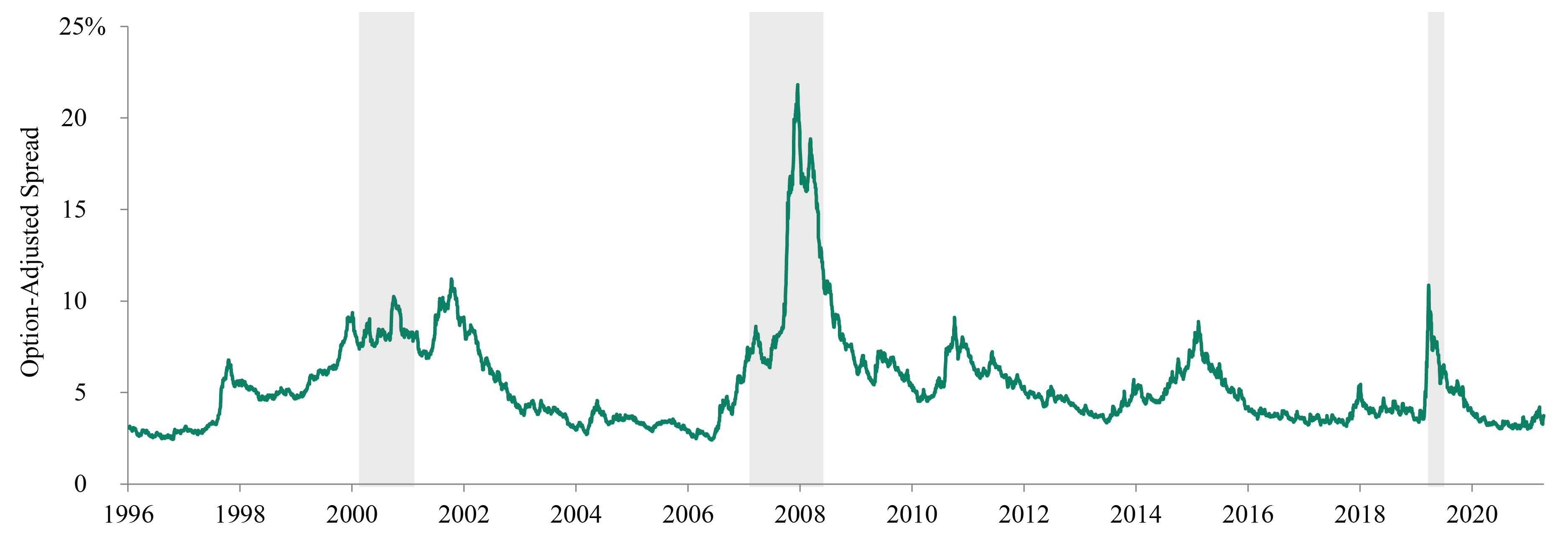
Source: ICE BoA U.S. High Yield Bond Index
WARNING: YIELD TO THE FED
In addition to a potential economic downturn and geopolitical tensions, investors are also facing an imminent decline in market liquidity, as the Fed prepares to begin shrinking its balance sheet. Quantitative tightening could be disruptive to securities markets in ways that are more challenging for investors to model than rising interest rates, for the simple reason that balance sheet reduction on the massive scale currently anticipated has never occurred before. When looking at the performance of asset classes over the last decade, it seems clear that quantitative easing had a positive impact on security prices. So it’s reasonable to assume that quantitative tightening will have the opposite effect. However, the ramifications of this profound shift in monetary policy may not be straightforward.
It’s instructive, for example, to consider how changes in the Fed’s balance sheet have impacted – and could impact – one asset class: collateralized loan obligations (CLOs).
As the Fed added over $4.6 trillion in assets to its balance sheet in 2020–21, it also accrued liabilities representing the same amount. This meant banks were flooded with excess reserves (i.e., capital above the amount that regulators require private banks to hold on deposit at the central bank). These reserves earned almost no interest, so banks dealt with this glut by using that capital to buy safe assets that earned slightly higher interest rates, such as AAA-rated CLO tranches. This is one of the main reasons why CLO primary market activity soared to record-breaking heights in recent years.10
This technical backdrop has shifted dramatically as the Fed has begun to tighten monetary policy. In March, the Fed ended its quantitative easing program, meaning it is no longer seeking to be a net buyer of assets. Banks therefore aren’t regularly accumulating reserves and thus no longer need to buy assets like AAA CLOs. Moreover, the Fed is now also paying a higher interest rate on reserves, and Treasurys are offering higher yields, so CLOs look less attractive by comparison.
Consequently, demand has declined for low-risk CLO tranches, which make up roughly 65% of each CLO, and CLO primary market activity slowed accordingly in the first quarter.11 CLO managers have therefore been forced to offer wider yield spreads on AAA tranches in order to complete deals, even though the underlying credit fundamentals of CLOs remain strong. (The default rate for the underlying leveraged loans is below 1%.)12 This has created attractive opportunities for CLO investors able to withstand the market weakness.
Note that the Fed hasn’t even started to reduce its balance sheet. Once it does, there will be fewer reserves in the banking system, so banks will have even less need to buy low-risk CLOs. At some point, banks may have to begin selling their CLO holdings to ensure they’re maintaining the required amount of reserves.
What are some of the implications of this shift?
-
Yields on AAA CLOs may increase to the point that these securities start to compete with higher-risk investments, which could force the yields of the latter to rise.
-
The prices of riskier CLO tranches (which aren’t held by banks) could increase, because the demand for these tranches likely won’t decline, but the supply of new CLOs probably will.
-
The reduced pace of CLO issuance and higher yields demanded by CLO investors could restrict the availability of credit to companies borrowing money through the underlying loans, leading to defaults by those unable to refinance.
The potential impacts of quantitative tightening are far from clear-cut. But it’s reasonable to assume that this phenomenon could create volatility and periods of weakness across credit markets over the next year. Investors have grown accustomed to plentiful liquidity; they may not respond well once the pool starts to be drained.
ON THE HORIZON
At Oaktree, we don’t believe in placing bets based on macroeconomic predictions. But we do think it’s important to pay attention to the major forces impacting securities markets, the economy, industries and individual companies. In other words, sometimes thinking about macro is necessary.
We believe the environment created by the aforementioned policy actions will likely be challenging for many credit classes – especially those with high sensitivity to interest rate increases, such as high yield bonds, or exposure to equities, like convertible bonds. However, we also think disciplined long-term investors may find compelling opportunities as they navigate this uncertain transitional period:
(1) European markets may offer attractive relative value, but this comes with significant tail risk
Yield spreads on European high yield bonds and leveraged loans are wider than those on similarly rated debt in the U.S. But controlling for risk in Europe will likely be far more difficult than in the U.S. because of Europe’s proximity to the war in Ukraine, energy security concerns, and weaker economic activity.
Look at Germany, the biggest economy in the eurozone. The country’s GDP declined by 0.7% in 4Q2021 because of slowing economic growth in China, its largest trading partner. The German government’s council of economic advisors recently reduced the country’s 2022 growth forecast from 4.6% to 1.8%. But this projection could prove far too optimistic if China’s zero-Covid policy continues to depress economic activity – and especially if Europe’s gas imports from Russia are disrupted or halted entirely, since Germany is heavily dependent on Russian energy.
Investors in European credit may seek to control risk by focusing on companies that have limited exposure to Russia and the ability to withstand a sustained period of low growth and rising inflation (particularly high energy costs). We believe disciplined credit selection is always key to superior investing, but we think it’s especially important when the probability of extreme downside scenarios is no longer insignificant.
(2) Latin American credit may be a temporary haven for emerging markets debt investors
Latin American debt could be well positioned in 2022 because it may benefit from some of the factors that have generated weakness across global markets in recent months, including elevated commodity prices, concerns about Chinese government policies, and geopolitical tensions.
In 2021, Latin American economies rebounded from their 2020 slump as Covid-19-related lockdowns were eased and global consumption of commodities increased. The region’s corporate default rate fell by 1.9 percentage points to reach 2.5% at year-end,13 and GDP growth in the region rose to 6.8%.14 At the same time, inflation increased across Latin America, so some of the region’s central banks started to hike interest rates aggressively. For example, the Central Bank of Brazil began to raise its key policy rate in early 2021 and has done so eight more times during this tightening cycle.
While restrictive monetary policy obviously kept the region’s economy from rebounding even faster, high interest rates are now benefiting many of Latin America’s currencies and making its corporate debt more attractive to foreign investors. Bullishness about the region is also rising because it is home to many large commodity-exporting nations, such as Brazil and Argentina, that are enjoying improving terms of trade. Meanwhile, alternatives for emerging markets debt investors have become less attractive in recent months, given Russia’s invasion of Ukraine and the volatility in Chinese asset prices.
Risk stemming from the political realm exists in Latin America, especially as presidents who espouse some worrisome economic policies were elected in Peru and Chile during the last year. However, EM debt investors may find that the region provides temporary shelter from geopolitical storms.
(3) Compelling private debt opportunities may be found in the non-sponsor-backed market
Debt issuance in private markets was expected to be robust in 2022, following a record-setting year in which U.S. middle-market loan volume hit $319 billion.15 This was partly because private equity firms came into the year with a tremendous amount of dry powder to support M&A activity. However, we now believe rising interest rates, declining valuation multiples, and persistent inflationary pressures could reduce private-equity-backed deal flow in the coming months. While issuers may favor private over public funding sources due to the ongoing volatility in public markets, competition to provide private financing may be significant.
Attractive opportunities to lend may therefore increasingly be located in the non-sponsor-backed market, in situations where the required financing solutions are bespoke, assets are difficult to value, and sector-specific expertise is rewarded. Private debt usually offers the potential for higher yields than public credit with lower volatility, but we believe accessing this value may increasingly require a specialized toolkit.
ASSESSING RELATIVE VALUE
PERFORMANCE OF SELECT INDICES
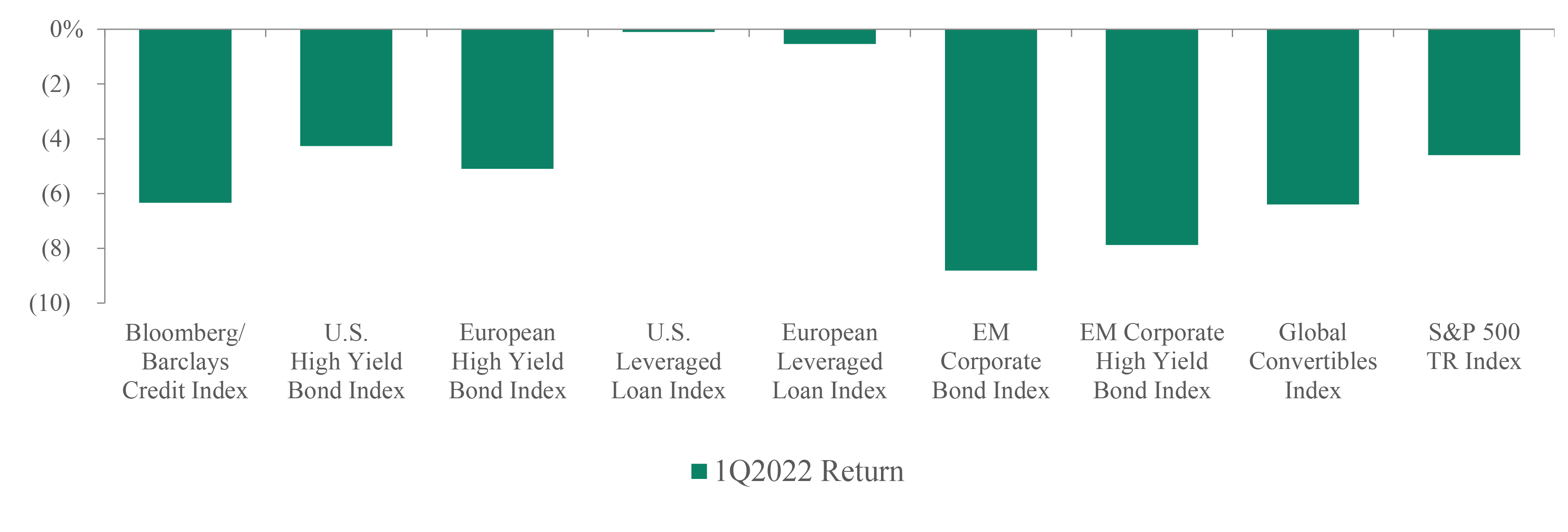
As of March 31, 2022
Sources: Bloomberg Barclays, Credit Suisse, FTSE, ICE BofA, JP Morgan, S&P Global, Thomson Reuters16
DEFAULT RATES BY ASSET CLASS

Sources: Bank of America, Credit Suisse, JP Morgan17
STRATEGY FOCUS
HIGH YIELD BONDS
Market Conditions: 1Q2022
U.S. HIGH YIELD BONDS
Return: -4.3%18
Issuance: $46.5bn19
LTM Default Rate: 0.2%20
-
Rising interest rates weighed on fixed-rate assets: High yield bonds experienced one of their weakest quarters in recent years. Approximately 70% of U.S. high yield bonds offered yields above 5% at quarter-end.21
-
Duration was a key factor: The asset class outperformed investment grade bonds, primarily because of the latter’s higher sensitivity to interest rate increases (see Fig. 6).22 High yield bonds with the longest duration underperformed.23
-
Credit concerns rose, but remain limited: Yield spreads expanded notably following the invasion of Ukraine. While they narrowed to pre-invasion levels by quarter-end, they still widened during the quarter.
EUROPEAN HIGH YIELD BONDS
Return: -5.1%24
Issuance: €10.8bn25
LTM Default Rate: 0.0%26
-
Yield spreads are attractive on a relative basis: At quarter-end, yield spreads in the asset class were approximately 320 bps wider than those of European investment grade bonds.27
-
Exposure to Russia/Ukraine differentiated managers: The European high yield bond market has limited direct exposure to either country, so managers who were overweight to either significantly underperformed the benchmark.
Outlook
Opportunities
-
Default risk remains low: While analysts anticipate that default rates in the U.S. and European high yield bond markets will increase in 2022, they expect these rates to remain well below their long-term historical averages.28 Issuers’ fundamentals are healthy despite macroeconomic concerns, and near-term maturities are minimal following the 2020–2021 wave of refinancings.
-
Covenant-lite loans are providing highly leveraged U.S. companies with flexibility: High yield bond issuers have had access to loans with few restrictions or requirements (i.e., cov-lite loans). While such borrowing may increase risk in the long term, access to this relatively unrestricted source of capital makes bond/loan issuers less likely to default on their bonds in the near term.
Risks
-
Tightening monetary policy could harm heavily indebted companies: Low-rated corporate issuers might struggle to roll over debt as interest rates increase, especially if the economy also slows significantly. This could cause default rates to increase more than analysts currently anticipate.
-
Elevated inflation could impair issuers’ fundamentals: Companies facing rising input costs may be unable to pass along price increases to customers. Reduced earnings could negatively impact leverage ratios and potentially lead to credit rating downgrades.
-
Credit risk appears to be higher in Europe: The likelihood of a recession in 2022 is higher in Europe than in the U.S., given both the former’s proximity to the war in Ukraine and energy security concerns. The European high yield bond market has substantial exposure to energy-intensive industries, such as auto manufacturing.
Figure 6: High Yield Bonds Are Less Sensitive to Interest Rate Increases Than Investment Grade Bonds
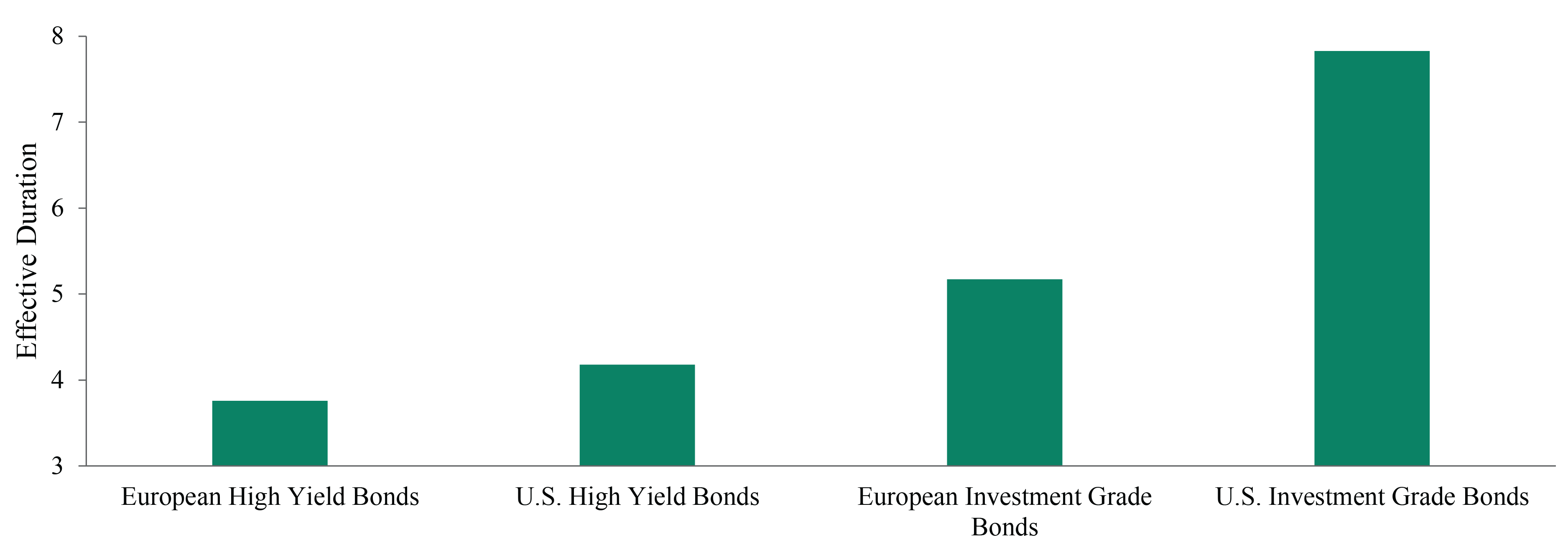
Source: ICE BofA Global High Yield European Issuers Non-Financial Excluding Russia Index, ICE BofA US High Yield Index, ICE BofA Euro Corporate Index, ICE BofA US Corporate Index; as of March 31, 2022
SENIOR LOANS
Market Conditions: 1Q2022
U.S. SENIOR LOANS
Return: -0.1%29
Issuance: $112.9bn30
LTM Default Rate: 0.4%31
-
U.S. loans were resilient in 1Q2022: They outperformed most other asset classes with far less volatility (see Fig. 4).
-
Retail demand remained very strong: Mutual funds and ETFs recorded their 16th consecutive month of inflows in March. Inflows for the quarter totaled $18.7bn, the second-highest quarterly amount ever (see Fig. 7).32
-
The default environment remains benign: The U.S. trailing-12-month default rate fell by almost 300 bps in the 12 months through March.33 Borrowers’ fundamentals have continued to improve.34
EUROPEAN SENIOR LOANS
Return: -0.5%35
Issuance: €19.0bn36
LTM Default Rate: 0.2%37
-
European loan prices declined only modestly as geopolitical concerns spiked: The Credit Suisse Western European Leveraged Loan Index benefited from having no direct exposure to Russia or Ukraine.
-
Distress remained very limited: Less than 2% of the European loan market was trading below 80% of par at quarter-end.38
Outlook
Opportunities
-
Loans offer attractive relative value: Both U.S. and European loans offered wider yield spreads than their regions’ high yield bonds at quarter-end.39
-
Rising interest rates should support relative performance: Credit investors will likely seek to shorten duration as central banks tighten monetary policy, making floating-rate loans more attractive in both regions.
-
Loans’ core buyer base is stable: Volatility in loans is usually lower than in other asset classes because (a) CLOs – the primary holders – have limited selling pressure and (b) the cash settlement period for loans is lengthy, so the asset class tends to attract long-term institutional investors (see Fig. 8 for data on European loans).
Risks
-
Rising interest rates could prove challenging for highly indebted borrowers: The reference rates used in many loan contracts have risen significantly in recent months, making it more expensive for borrowers to service their debt.
-
Tightening central bank policy and the war in Ukraine could impede economic growth and increase defaults: While default risk remains muted, tail risk is growing – especially in Europe – highlighting the importance of disciplined credit selection.
-
High inflation could harm companies’ fundamentals: Borrowers may struggle to pass along cost inflation to customers, which could negatively impact their earnings and leverage ratios. European borrowers, in particular, may be vulnerable, as energy prices are likely to remain high.
-
Loan quality has declined in recent years: Issuer-friendly loans may have encouraged imprudent borrowing, which could prove problematic in an economic downturn.
Figure 7: Retail Inflows for Loans Remain Robust, While CLO Activity Has Slowed
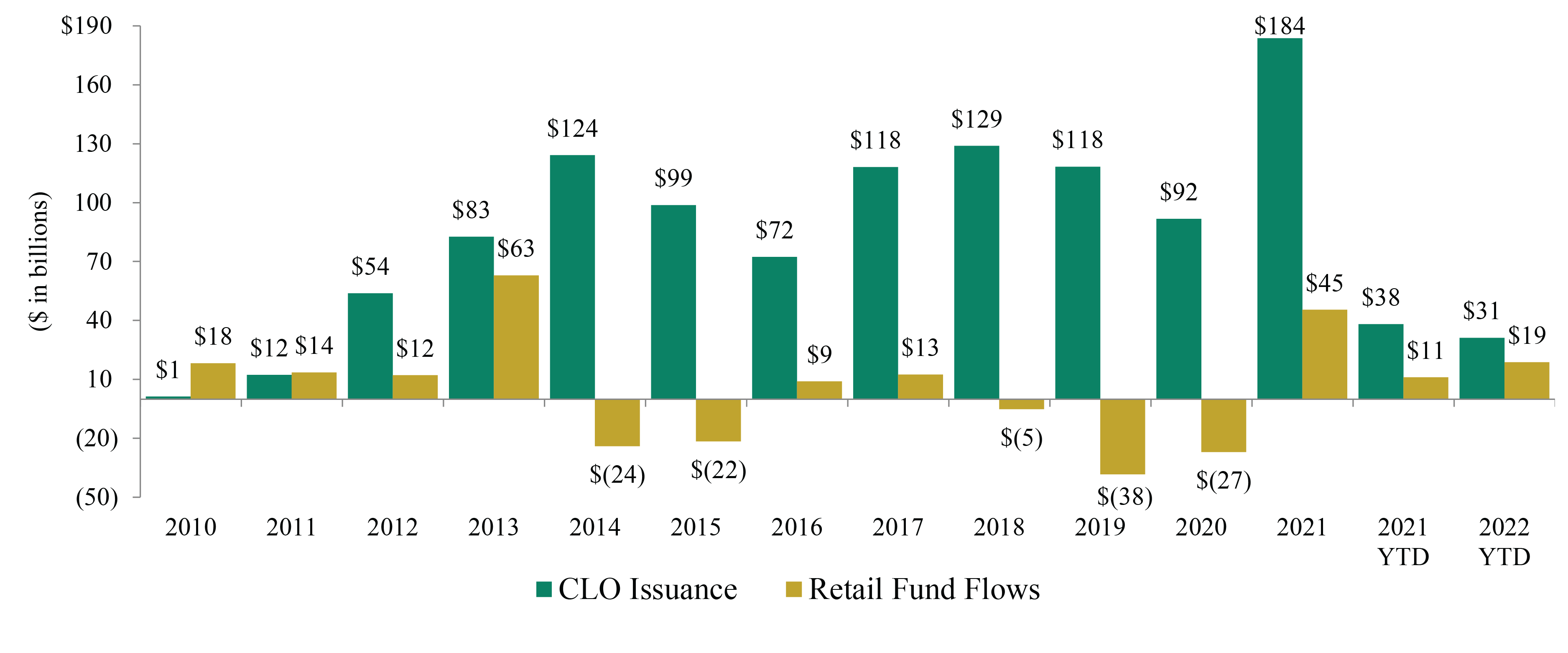
Source: JP Morgan
Figure 8: European Senior Loans Have a Stable Core Buyer Base
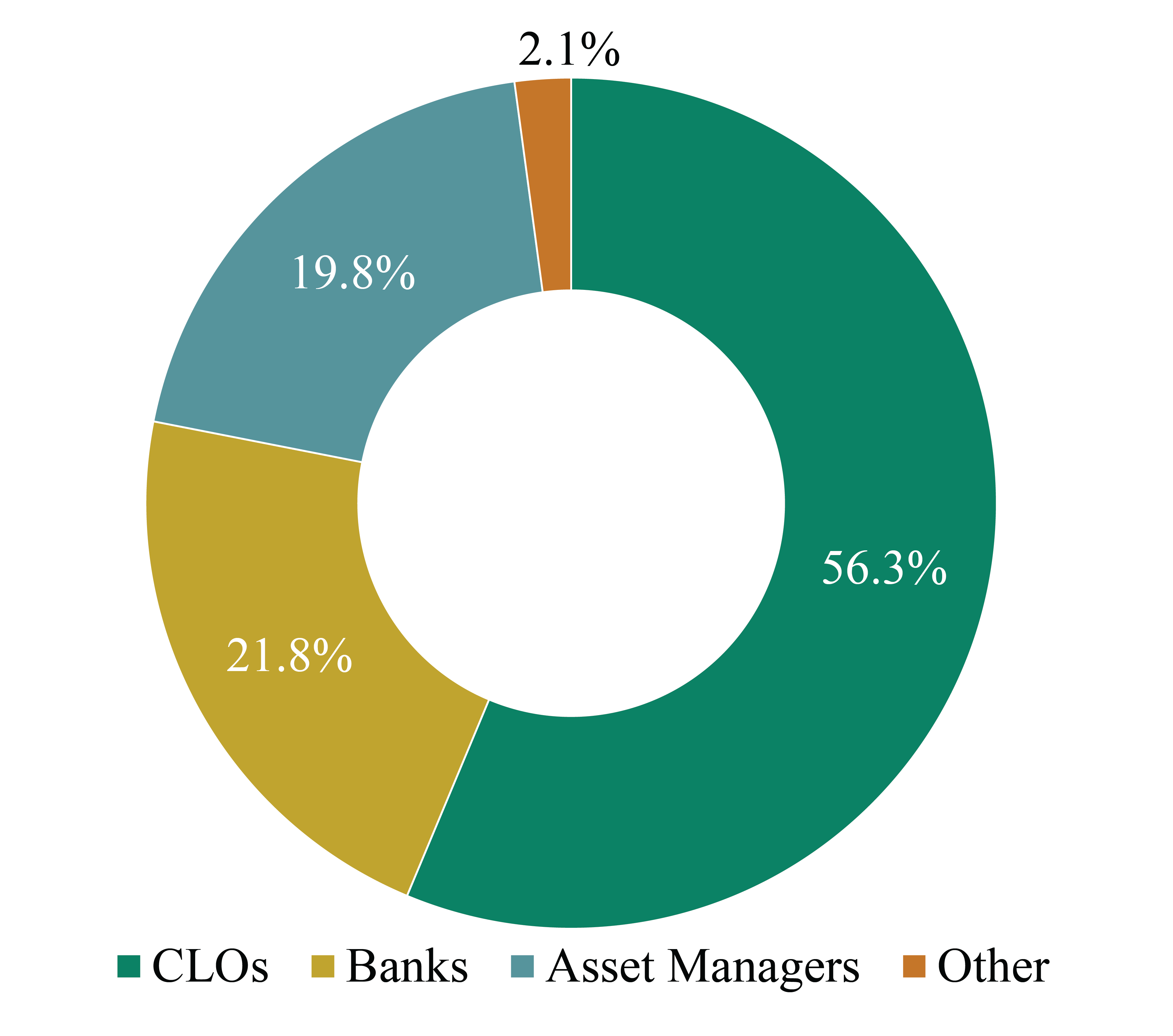
Source: S&P LCD; percentage of senior loan market; as of March 31, 2022
EMERGING MARKETS DEBT
Market Conditions: 1Q2022
EM Corporate Bond Return: -8.8%40
EM Corporate High Yield Bond Return: -7.9%41
-
Geopolitical risk loomed large in emerging markets debt: Russia’s invasion of Ukraine led to a rapid exodus from Russia’s corporate and sovereign bond markets, which have a combined nominal value of +$140bn. Both Ukrainian and Russian corporate bond real yields spiked dramatically (see Fig. 9). The impact on other EM countries varied significantly based on whether the nation is a net exporter or net importer of major commodities.
-
Rising global interest rates weighed heavily on EM debt: EM bonds with relatively long duration performed especially poorly.
-
The default rate in China remained elevated: The default rate in China’s high yield bond market reached 6.8% in 1Q2022, primarily due to weakness in the country’s property sector.42 On an annualized basis, this default rate is higher than the 19.4% recorded in 2021 and well above the country’s long-term historical average default rate.43
-
Corporate bond real yields remain negative in most EM countries: Rising inflation has eroded value, underscoring the disadvantages of an index-based approach to EM debt investment (see Fig. 10).
Outlook
Opportunities
-
Weakness emanating from China may create compelling buying opportunities: China represents a significant portion of the EM high yield bond market. Capital outflows from the asset class could increase if investors grow more concerned about slowing Chinese growth or defaults in the country’s property sector. This could cause the debt of EM companies with strong fundamentals to trade at stressed prices.
-
EM issuers that can generate consistent cash flow could prove resilient in a challenging environment: Such companies should be able to meet their debt service obligations even if central banks tighten monetary policy aggressively and global economic growth slows.
-
Latin American debt may provide a (temporary) safe haven: Capital has flowed into the region, because it benefits from soaring commodity prices and is fairly well insulated from geopolitical tensions in Europe. However, uncertainty related to political situations in Chile, Peru, Argentina and Brazil poses a medium-term risk.
Risks
-
Increasing threats to global economic growth, including China’s zero-Covid policy, may negatively impact EM economies: China set a 5.5% global GDP growth target for 2022.44 While this target is low for China, it could still prove challenging to meet because recent Covid-19 lockdowns could weigh on the country’s economic activity.
-
EM economies could suffer as developed market central banks tighten monetary policy: EM countries and companies could struggle to roll over and service debt in a rising-interest-rate environment.
-
Intensifying political risk could weigh on EM credit prices: The war in Ukraine, rising populism in Latin America, and instability in Turkey could erode investor confidence in EM credit.
Figure 9: Real Yields on Russian and Ukrainian Corporate Bonds Have Spiked
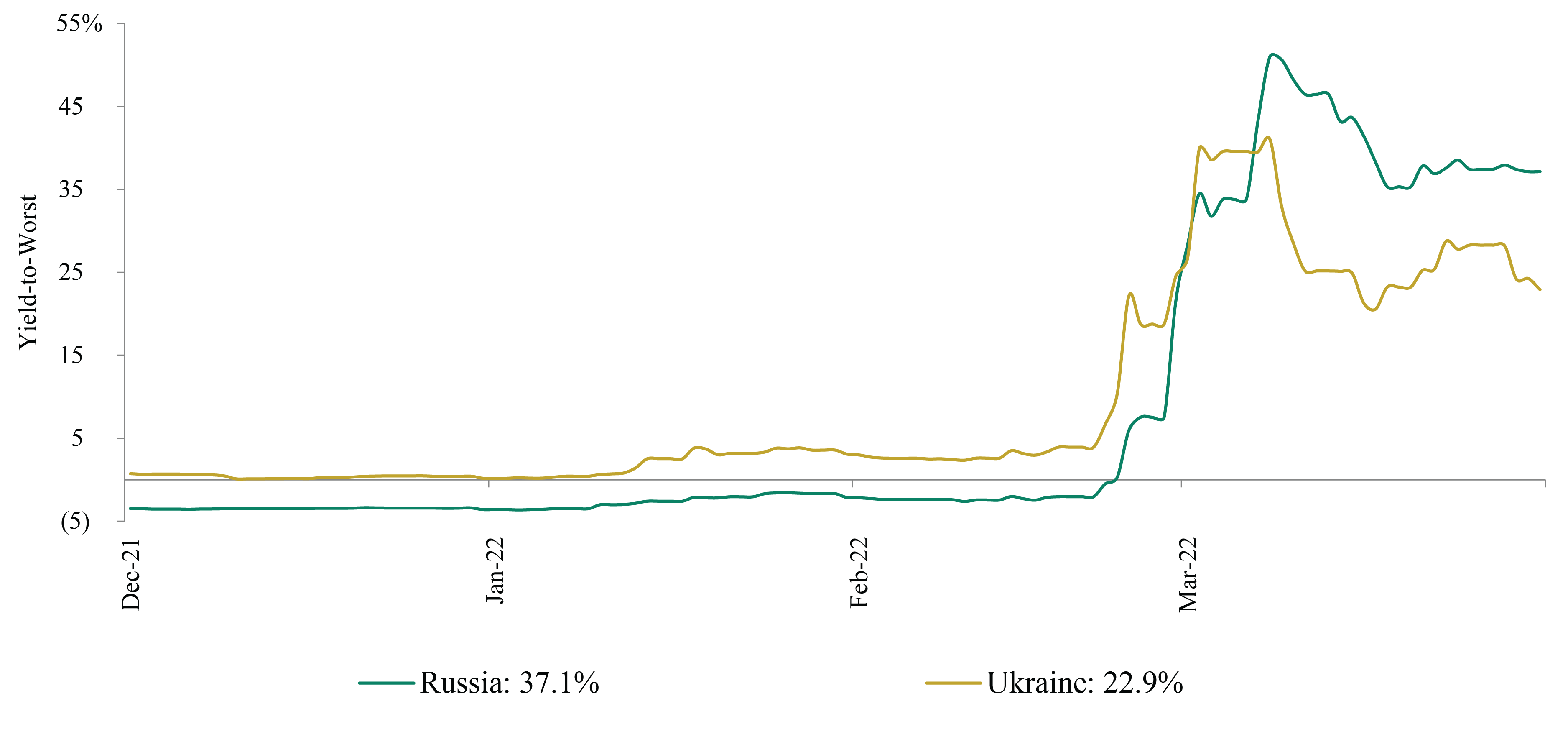
Source: Bloomberg
Figure 10: But Most EM Corporate Bond Real Yields Are Negative Due to Elevated Inflation
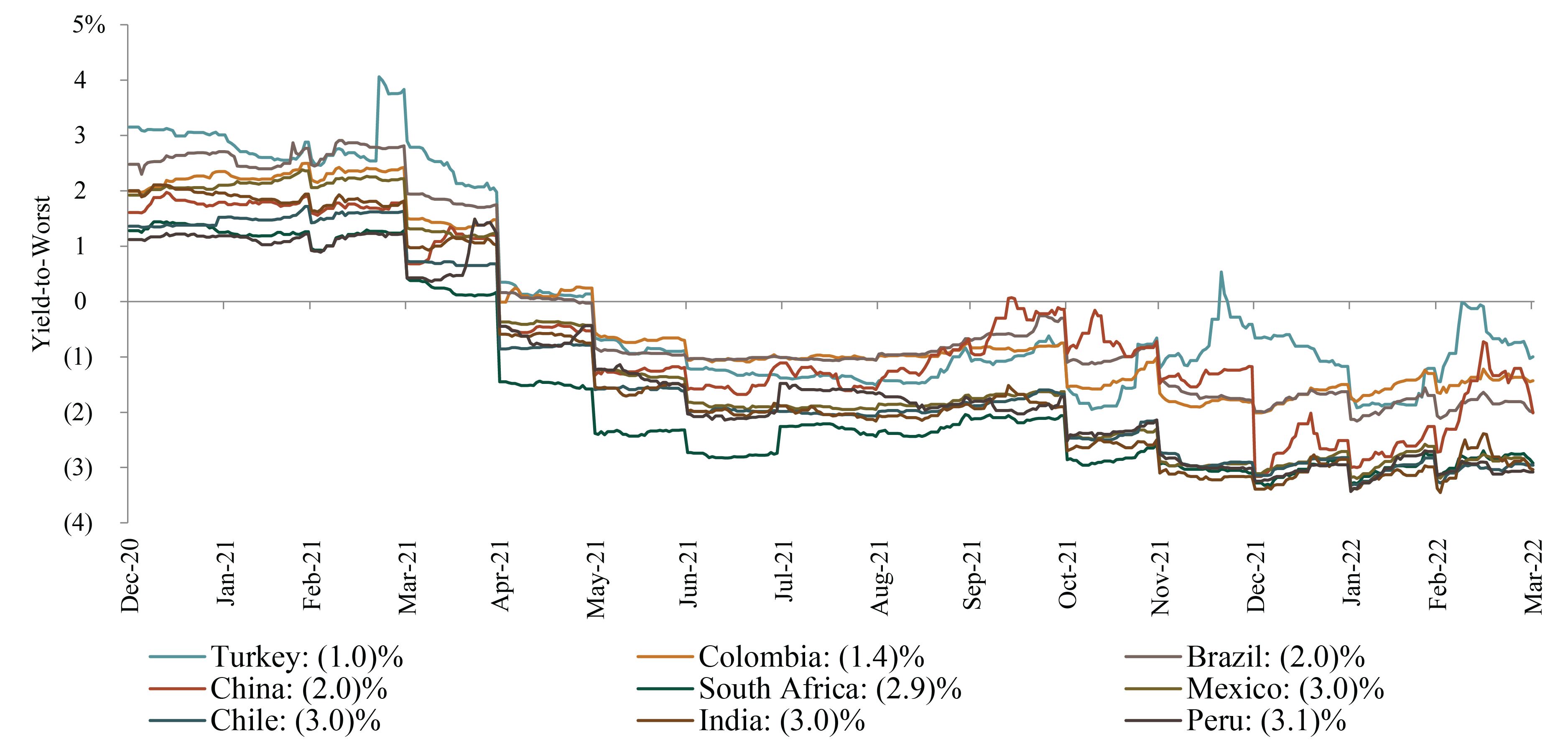
Source: Bloomberg
GLOBAL CONVERTIBLES
Market Conditions: 1Q2022
Return: -6.4%45
Issuance: $7.9bn46
LTM Default Rate: 0.9%47
-
The asset class’s performance lagged that of global equities in 1Q2022: The convertibles market is underweight many of the sectors that outperformed in the first quarter. It has significant exposure to high-multiple, high-growth issuers that are vulnerable to rising interest rates.
-
The war in Ukraine reduced investors’ risk appetite: Uncertainty surrounding the conflict and its potential effect on commodity prices and global growth weighed on equity prices, which drive convertibles performance.
Outlook
Opportunities
-
The challenging macroeconomic backdrop boosted yields: During 1Q2022, the asset class’s currency-hedged yield to maturity shifted from negative to positive for the first time in two years, ending the period at 0.1%.48
-
Robust issuance across sectors in 2020-21 has expanded the investment universe: Investors who are seeking to locate value under challenging market conditions have an expansive, diverse opportunity set (see Fig. 11).
-
Market weakness could create buying opportunities: Value-oriented convertibles investors may be able to identify bargains in this environment, as an increasing number of bonds are trading below par.49
Risks
-
Multiple trends threaten to push down economic growth and equity prices: These include the war in Ukraine, high commodity prices, elevated inflation, declining consumer sentiment, rising Covid-19 cases in China (and the government’s zero-Covid policy), tightening global monetary policy, and the reduction in fiscal support in most major economies.
-
High-multiple equities and Chinese stocks remain vulnerable: Convertibles are highly exposed to (a) growth-oriented stocks, which may continue to decline in value if interest rates keep rising and (b) Chinese equities, which were extremely volatile in the first quarter.
Figure 11: The Global Convertibles Market Remains Well Above Its Pre-Pandemic Size
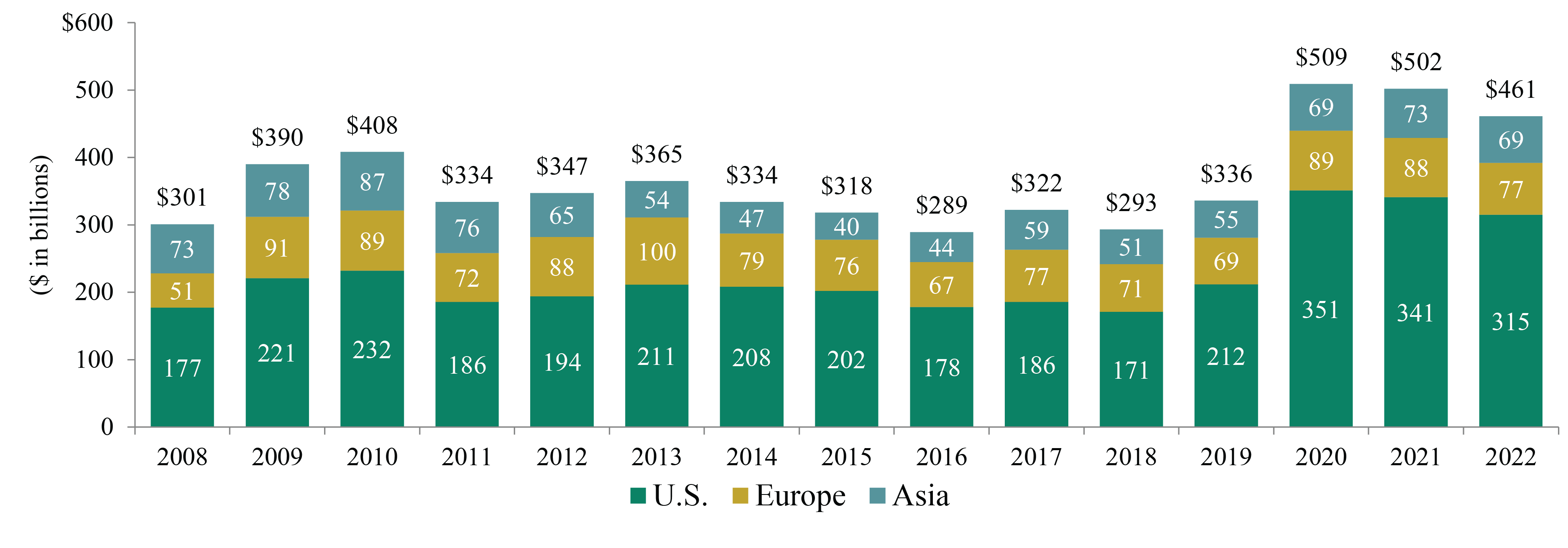
Source: Bank of America
STRUCTURED CREDIT
Market Conditions: 1Q2022
CORPORATE
BB-Rated CLO Return: -0.3%50
BBB-Rated CLO Return: 0.0%51
U.S. CLO Issuance: $30.9bn52
European CLO Issuance: €9.8bn53
-
Primary market activity stalled in 1Q2022: Issuance was limited following a record-breaking year in 2021.54 The slowdown was likely related to the following: (a) the Federal Reserve’s policy changes have reduced demand for AAA-rated CLO tranches and (b) investors took time to adjust to the mandatory transition from LIBOR to SOFR55 that became effective at year-end.
-
Geopolitical risk and tightening monetary policy weighed on prices: The war in Ukraine and the shift toward quantitative tightening have negatively impacted the asset class, though corporate structured credit performed far better than primarily fixed-rate asset classes.56
REAL ESTATE
BBB-Rated CMBS Return: -5.4%57
-
The primary market remained very active: Issuance of Single-Asset Single-Borrower commercial mortgage-backed securities totaled $43.8bn in 1Q2022, well above the $23.6bn recorded in 1Q2021.58
-
Yield spreads have widened: Rising interest rates, the lingering pandemic, and the broad decline in risk appetite weighed on real-estate-backed securities.
Outlook
Opportunities
-
BB-rated CLO debt tranches have many sources of potential value: These instruments have attractive structural and credit enhancements as well as low sensitivity to interest rates increases (See Fig. 12). European CLOs also have no direct exposure to Russia or Ukraine.
-
Weakness in real-estate-backed securities may create compelling opportunities for disciplined investors: We believe the risk/return profile has improved for SASB CMBS and conduit CMBS, but we also think disciplined credit analysis is necessary in this challenging environment.
Risks
-
CLOs have historically performed poorly during bouts of equity market weakness: While CLOs have been relatively resilient in 2022, performance could deteriorate if the conflict in Ukraine, rising inflation, or tightening monetary policy cause significant economic damage or reduce investor appetite for risk.
-
Widening yield spreads could limit primary market activity in real-estate-backed securities: Issuers may be unwilling to offer the yields demanded by investors, limiting the opportunity set.
Figure 12: Structured Credit Offers Attractive Yields Relative to Traditional Debt
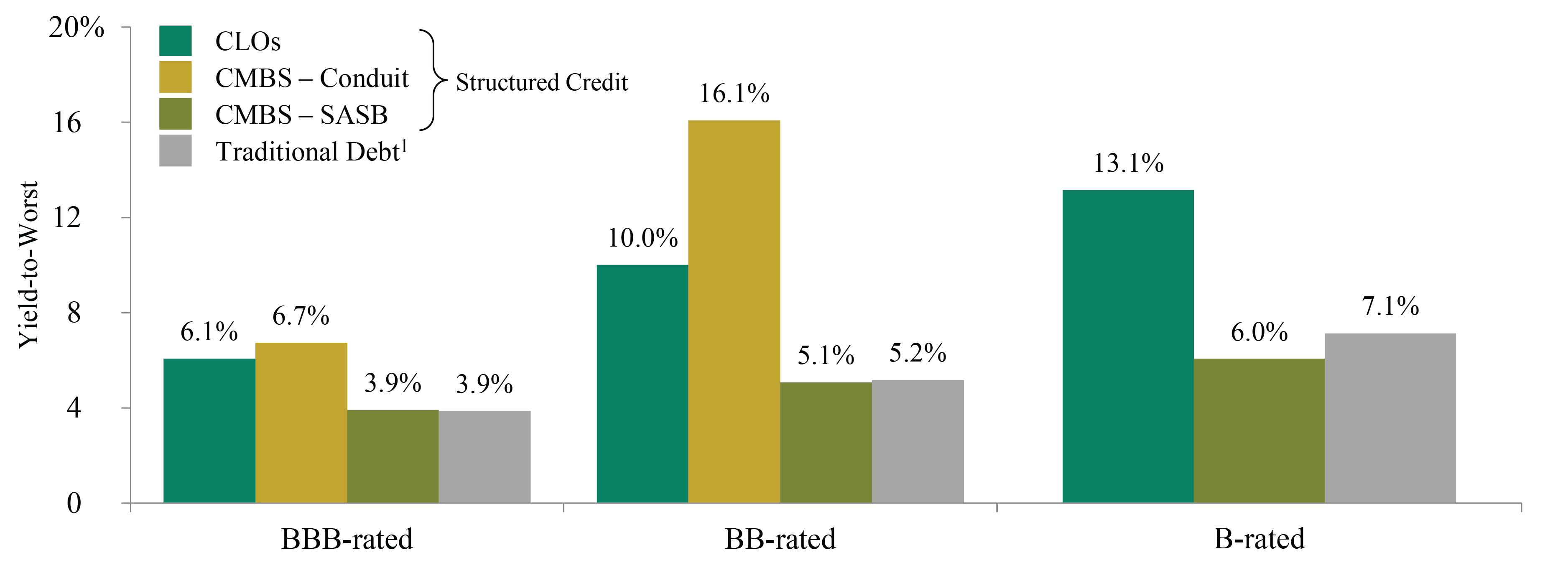
Source: Bloomberg Barclays Index Services, FTSE Global Markets, Credit Suisse, JP Morgan
PRIVATE CREDIT
Market Conditions: 1Q2022
-
Private credit is still a borrower-friendly market: Competition to lend in this market remains fierce, despite escalating geopolitical and macroeconomic concerns. New deals continue to feature high leverage multiples and low coupons.
-
European bank lending has declined year-over-year: Lending to corporate borrowers increased month-over-month in January and February, but outstanding loans were 3.4% lower than they were in the same period last year.59
-
Europe’s economy is in a vulnerable position: The unemployment rate in the eurozone fell to 6.8% in February, but inflation surged from 5.0% in January to 7.5% in March, primarily because of the war in Ukraine.60 The conflict – and the related surge in energy prices – are likely to weigh on the region’s economic health moving forward, as is the prospect of tightening monetary policy. The slowdown in China’s economy also poses a risk to Europe, as China is the eurozone’s largest trading partner.
Outlook
Opportunities
-
The non-sponsor-backed market may provide compelling opportunities: Volatility in public markets may increase demand for private sources of capital, but rising interest rates and declining valuation multiples could reduce private-equity-backed deal flow in the coming months. Attractive opportunities may increasingly be found in the non-sponsor-backed market in deals requiring bespoke financings.
-
Rising interest rates and slowing economic growth may make European banks less willing to lend: European borrowers outside the sponsor-backed market have traditionally had to rely on banks or informal sources of capital, but these borrowers may now turn to direct lenders as bank lending declines.
-
Fast-growing life sciences and software companies may access capital through direct lending markets: We expect that significant lending opportunities will develop in these industries, driven by technological advancements and sizable research & development requirements.
Risks
-
Businesses’ fundamentals could decline in 2022: Shortages of labor and key inputs could impede economic growth and weigh on the earnings of companies that can’t pass rising costs onto customers.
-
Recession risk is increasing: If the U.S. economy contracts in 2022 or 2023, private equity sponsors may not inject capital into struggling companies like they did in 2020-21. Sponsors may have already met their investment caps or believe they won’t earn a sufficient return.
-
Tightening monetary policy could negatively impact the lending environment in the U.S. and Europe: The U.S. has already begun to hike interest rates, and the ECB is now expected to increase interest rates multiple times in 2022 (see Fig. 13). Higher interest rates may discourage new borrowing and make it challenging for current borrowers to roll over their debt. This situation could make defaults more likely.
Figure 13: The ECB Is Expected to Hike Interest Rates Aggressively
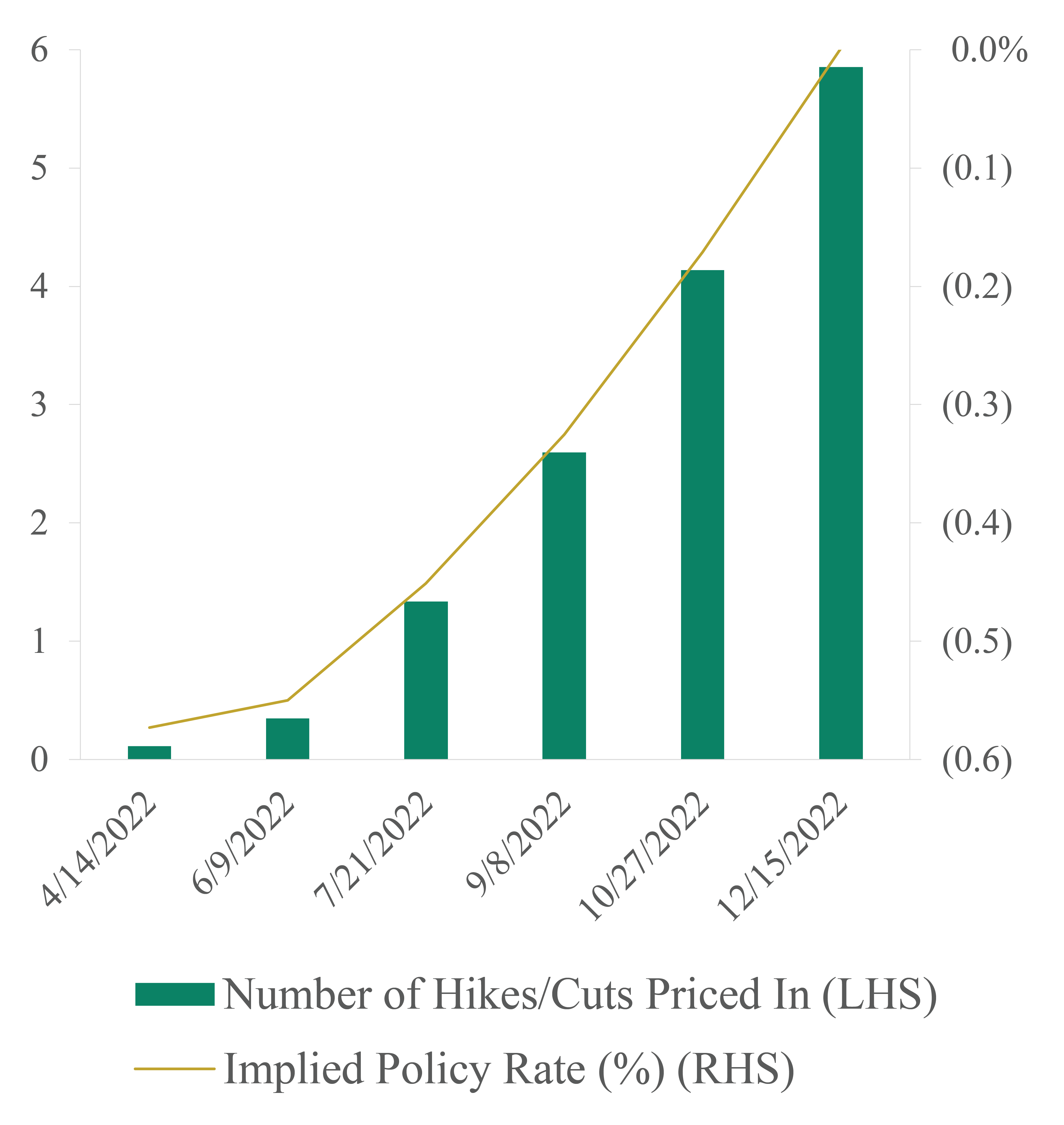
Source: Bloomberg
ABOUT OAKTREE’S PERFORMING CREDIT PLATFORM
Oaktree Capital Management is a leading global alternative investment management firm with expertise in credit strategies. Our Performing Credit platform encompasses a broad array of credit strategy groups that invest in public and private corporate credit instruments across the liquidity spectrum. The Performing Credit platform, headed by Armen Panossian, has $56.2 billion in AUM and approximately 190 investment professionals. 61
ENDNOTES
1 U.S. Bureau of Labor Statistics.
2 Board of Governors of the Federal Reserve System.
3 Bloomberg.
4 Expected change in 3-month interest rates over the next year represents the difference between the 4th Euribor Future and the 1st Euribor Future.
5 U.S. Department of the Treasury.
6 S&P 500 Index, U.S. Aggregate Corporate Bond Index, Citi U.S. High Yield Cash Pay Capped Index.
7 Credit Suisse Leveraged Loan Index, Citi U.S. High Yield Cash Pay Capped Index.
8 U.S. Bureau of Labor Statistics, 12 months through March 2022.
9 Consumer sentiment measured by the University of Michigan and Conference Board surveys, as of March 31, 2022.
10 JP Morgan.
11 JP Morgan.
12 JP Morgan, as of March 31, 2022.
13 JP Morgan.
14 International Monetary Fund.
15 Refinitiv.
16 The indices used in the graph are: Bloomberg Barclays Government/Credit Index, Credit Suisse Leveraged Loan Index, Credit Suisse Western European Leveraged Loan Index (EUR hedged), FTSE High-Yield Cash-Pay Capped Index, ICE BofA Global Non-Financial HY European Issuers ex-Russia Index (EUR Hedged), Refinitiv Global Focus Convertible Index (USD Hedged), JP Morgan CEMBI Broad Diversified Index (Local), JP Morgan Corporate Broad CEMBI Diversified High Yield Index (Local), and S&P 500 Total Return Index.
17 Trailing-12-Month Default Rate.
18 FTSE High Yield Cash-Pay Capped Index.
19 JP Morgan.
20 JP Morgan.
21 ICE BofA U.S. High Yield Master II Constrained Index.
22 JP Morgan.
23 FTSE High Yield Cash-Pay Capped Index.
24 ICE BofA Global Non-Financial High Yield European Issuer, Excluding Russia Index (EUR hedged).
25 S&P Global Leveraged Commentary & Data.
26 Credit Suisse.
27 ICE BofA Euro Corporate Index; ICE BofA Global Non-Financial High Yield European Issuer, Excluding Russia Index (EUR hedged).
28 JP Morgan.
29 Credit Suisse Leveraged Loan Index.
30 JP Morgan; net issuance.
31 JP Morgan; Excludes distressed exchanges.
32 JP Morgan.
33 JP Morgan.
34 JP Morgan; based on average earnings, interest coverage, and leverage ratios through 4Q2021.
35 Credit Suisse Western Europe Leveraged Loan Index (EUR hedged).
36 S&P Global Leveraged Commentary & Data; gross issuance.
37 Credit Suisse.
38 Credit Suisse Western Europe Leveraged Loan Index (EUR hedged).
39 Credit Suisse Leveraged Loan Index; FTSE High Yield Cash-Pay Capped Index; Credit Suisse Western Europe Leveraged Loan Index (EUR hedged); ICE BofA Global Non-Financial High Yield European Issuer, Excluding Russia Index.
40 JP Morgan CEMBI Broad Diversified Index.
41 JP Morgan Corporate Broad CEMBI Diversified High Yield Index.
42 JP Morgan.
43 JP Morgan.
44 National Bureau of Statistics of China.
45 Refinitiv Global Focus Convertible Index.
46 Bank of America; gross issuance.
47 Bank of America.
48 Refinitiv Global Focus Convertible Index.
49 Refinitiv Global Focus Convertible Index.
50 JP Morgan CLO 2.0 BBB Index.
51 JP Morgan CLO 2.0 BB Index.
52 JP Morgan; new issue only, so doesn’t include refinancings and resets.
53 JP Morgan; new issue only, so doesn’t include refinancings and resets.
54 JP Morgan.
55 Secured Overnight Financing Rate.
56 JP Morgan CLO 2.0 BBB Index, JP Morgan CLO 2.0 BB Index.
57 Barclays CMBS 2.0 BBB Index.
58 Barclays.
59 European Central Bank.
60 Eurostat.
61 The AUM figure is as of December 31, 2021 and excludes Oaktree’s proportionate amount of DoubleLine Capital AUM resulting from its 20% minority interest therein. The total number of professionals includes the portfolio managers and research analysts across Oaktree’s performing credit strategies.
NOTES AND DISCLAIMERS
This document and the information contained herein are for educational and informational purposes only and do not constitute, and should not be construed as, an offer to sell, or a solicitation of an offer to buy, any securities or related financial instruments. Responses to any inquiry that may involve the rendering of personalized investment advice or effecting or attempting to effect transactions in securities will not be made absent compliance with applicable laws or regulations (including broker dealer, investment adviser or applicable agent or representative registration requirements), or applicable exemptions or exclusions therefrom.
This document, including the information contained herein may not be copied, reproduced, republished, posted, transmitted, distributed, disseminated or disclosed, in whole or in part, to any other person in any way without the prior written consent of Oaktree Capital Management, L.P. (together with its affiliates, “Oaktree”). By accepting this document, you agree that you will comply with these restrictions and acknowledge that your compliance is a material inducement to Oaktree providing this document to you.
This document contains information and views as of the date indicated and such information and views are subject to change without notice. Oaktree has no duty or obligation to update the information contained herein. Further, Oaktree makes no representation, and it should not be assumed, that past investment performance is an indication of future results. Moreover, wherever there is the potential for profit there is also the possibility of loss.
Certain information contained herein concerning economic trends and performance is based on or derived from information provided by independent third-party sources. Oaktree believes that such information is accurate and that the sources from which it has been obtained are reliable; however, it cannot guarantee the accuracy of such information and has not independently verified the accuracy or completeness of such information or the assumptions on which such information is based. Moreover, independent third-party sources cited in these materials are not making any representations or warranties regarding any information attributed to them and shall have no liability in connection with the use of such information in these materials.
© 2022 Oaktree Capital Management, L.P.
Informações sensíveis e divulgação
Este memorando expressa as opiniões do autor na data indicada e tais opiniões estão sujeitas a alterações sem aviso prévio. A Oaktree não tem a obrigação de atualizar as informações aqui contidas. Além disso, a Oaktree não faz nenhuma representação, e não se deve assumir que odesempenho dos investimentos passados é uma indicação de resultados futuros. Além disso, onde quer que haja potencial de lucro, também existe a possibilidade de prejuízo. Este memorando está sendo disponibilizado apenas para fins educacionais e não deve ser usado para qualquer outro propósito. As informações contidas neste documento não constituem e não devem ser interpretadas como uma oferta de serviços de consultoria ou uma oferta de venda ou solicitação de compra de quaisquer títulos ou instrumentos financeiros relacionados, em qualquer jurisdição. Certas informações contidas neste documento sobre tendências econômicas e desempenho são baseadas ou derivadas de informações fornecidas por fontes terceirizadas independentes. A Oaktree Capital Management, L.P. (“Oaktree”) acredita que as fontes das quais tais informações foram obtidas são confiáveis; no entanto, não pode garantir a exatidão de tais informações e não verificou de forma independente a exatidão ou integridade de tais informações ou as suposições nas quais tais informações se baseiam. Este memorando, incluindo as informações aqui contidas, não pode ser copiado, reproduzido, republicado ou postado na íntegra ou parcialmente, em qualquer formato, sem o consentimento prévio, por escrito, da Oaktree.

